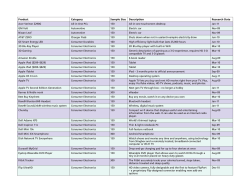
How To Build The Oh My Darling Rangemaster
How To Build The Oh My Darling Rangemaster By Steve Daniels, President, Small Bear Electronics LLC Contents Copyright 2013 By Small Bear Electronics LLC What Is The Oh My Darling Rangemaster? If you’ve heard of the Dallas Rangemaster, this pedal works in a similar way: A small capacitor at the input blocks low frequencies, and the amplifier stages following raise the volume of the signal that remains. A tone control potentiometer determines the effective size of the input capacitor, and so the amount of lows and mid-range that are let into the mix. But the pedal also adds subtle distortion by overdriving the Base of a Germanium transistor. The original Rangemaster used a single transistor. For reasons I’ll get into later, I chose to use two cascaded devices, called a Darlington pair, hence the name of the pedal. Those who are familiar with the Rangemaster will want to know that the printed circuit board provided can be configured as: A standard one-transistor Rangemaster The Two-NPN Device “Oh My Darling” Rangemaster A Hybrid NPN/PNP “Sziklai” Rangemaster This manual contains complete build instructions, and it is written to guide people who have never built a pedal before. (Experienced hobbyists note: You can skip sections as you need to.) I don't presume that you know any electronics, but you do need some minimum comfort with hand tools and I don't cover in here how to solder; more about these issues in the next section. That said, much of the information and many of the techniques shown here are applicable to building lots of other pedals, and even other electronic devices. I know that you'll enjoy building--and playing through!--the Oh My Darling. While I've done my best to make these instructions complete, I'm available by E-mail if you have questions, problems or suggestions. Yours In Good Music, Small Bear Electronics LLC 123 Seventh Avenue # 156 Brooklyn, NY 11215 Http://www.smallbearelec.com Smallbearelec@ix.netcom.com Contents Copyright 2013 By Small Bear Electronics LLC Can I Really Build It Myself? Yes, IF: You can follow directions. You are comfortable with using basic hand tools. You can solder well. If you have never soldered before, you may need to check out some how-to information on-line about that, also, and maybe practice a little before tackling this kit. Which brings me to: What Tools And Materials Will I Need? The case that we provide is powder-coated and pre-drilled, which cuts out a lot of work. You do need: A 25- to 35-watt soldering iron, rosin-core solder and cleaning sponge. NB: Yes, a Radio Shack iron will do, if the tip is relatively new and well-tinned. The big problem with very inexpensive irons is that the tips often aren’t properly clad, and so corrode quickly. Small screwdriver Small chain-nose plier and side-cutter Self-locking tweezers or other "third hand" Colored pencil or "Hi-liter" felt-tip marker Some small round and flat files A pointed steel "pick" or scratch awl De-soldering braid (like Radio Shack p/n 64-2090B) Contents Copyright 2013 By Small Bear Electronics LLC Identify The Components 5% Tolerance Carbon Film Resistors The values are in Ohms. The first two colored bands define the base number. The third band is the number of zeroes to add, and the gold fourth band indicates 5% tolerance. How Many? 2 1,000,000 ohm or 1 Megohm (Brown, Black, Green, Gold) 1 0 + 5 zeros 470,000 ohm (or 470 K ohm) (Yellow, Violet, Yellow, Gold) 1 10,000 (or 10 K ohm) (Brown, Black, Orange, Gold) 1 The four resistors below are selected to properly bias the transistors, so their values may differ. The typical values are: 68,000 (or 68 K ohm) (Blue, Gray, Orange, Gold) 1 2,200 ohm (or 2.2 K ohm) (Red, Violet, Red, Gold) 1 18,000 (or 18 K ohm) (Blue, Gray, Orange, Gold) 1 3,900 ohm (or 3.9 K ohm) (Orange, White, Red, Gold) 1 Potentiometers 250K Reverse Audio 10K Audio C250K A10K 1 1 Contents Copyright 2013 By Small Bear Electronics LLC Capacitors Metallized Polyester Film (Has no polarity) Quantity .0022 mf. .015 mf. .22 mf. Marked 1 1 1 222 153 224 Electrolytic (These are polarized; the black band marks the negative side.) Quantity 47 mf. 100 mf. 1 1 Transistors They come in many different case styles. The most common ones that we supply with the kit look like this: Diode – 1N5818 The band on the case indicates how it should be oriented on the PC board. LED The shorter lead is the negative side. Contents Copyright 2013 By Small Bear Electronics LLC Jacks Input – Switchcraft #112B Stereo Quantity 1 Ring Tip Sleeve Output - Switchcraft #111 Mono 1 Chamfer Tip Sleeve Chamfer External DC Power Stomp Switch 3PDT Latching Adhesive PCB Standoffs 3/8” 1 Quantity 1 Quantity 1 Contents Copyright 2013 By Small Bear Electronics LLC Molex Plugs and Headers 3-pin Vertical Header Quantity 2 3-pin Plug 2 2-pin Horizontal Header 2 3-pin Horizontal Header 1 6-pin Plug and Header 1 Each Terminated Leads, Various Colors 12 Input Connector 1 Output Connector 1 DC power Connector 1 Battery Snap 1 Contents Copyright 2013 By Small Bear Electronics LLC Enclosure 1 Main Printed Circuit Board 1 Potentiometer Board 1 Contents Copyright 2013 By Small Bear Electronics LLC
© Copyright 2025





















